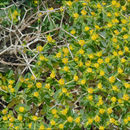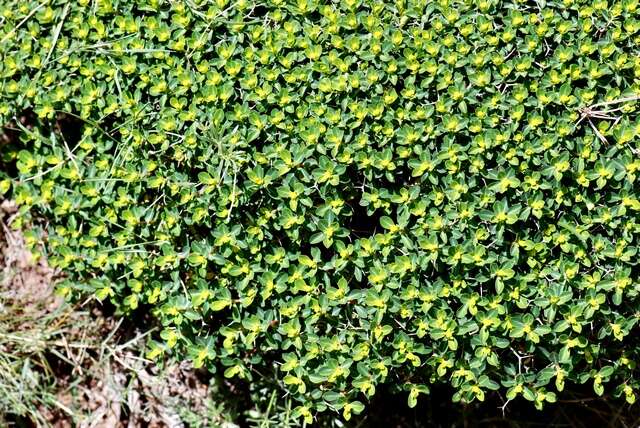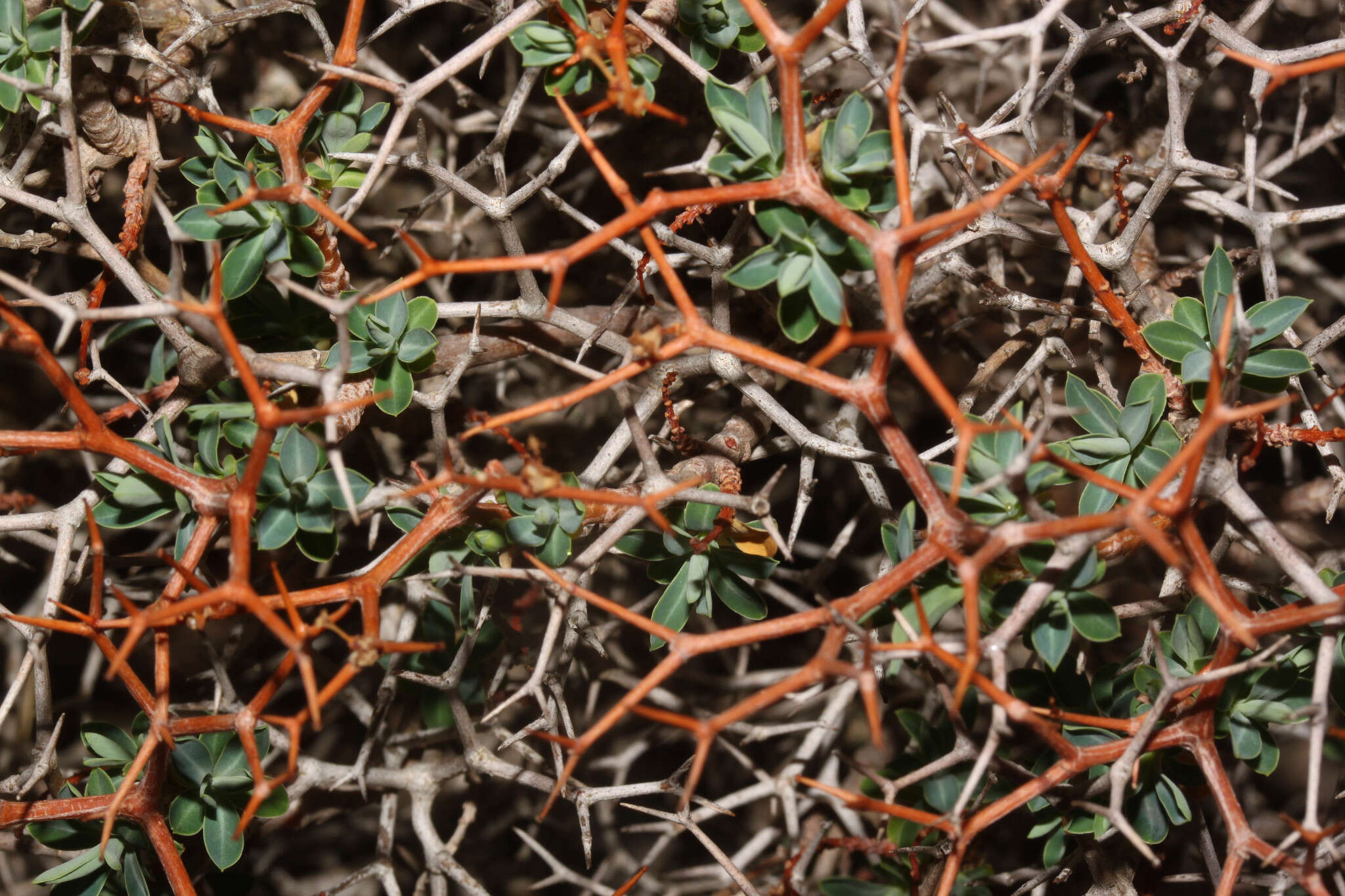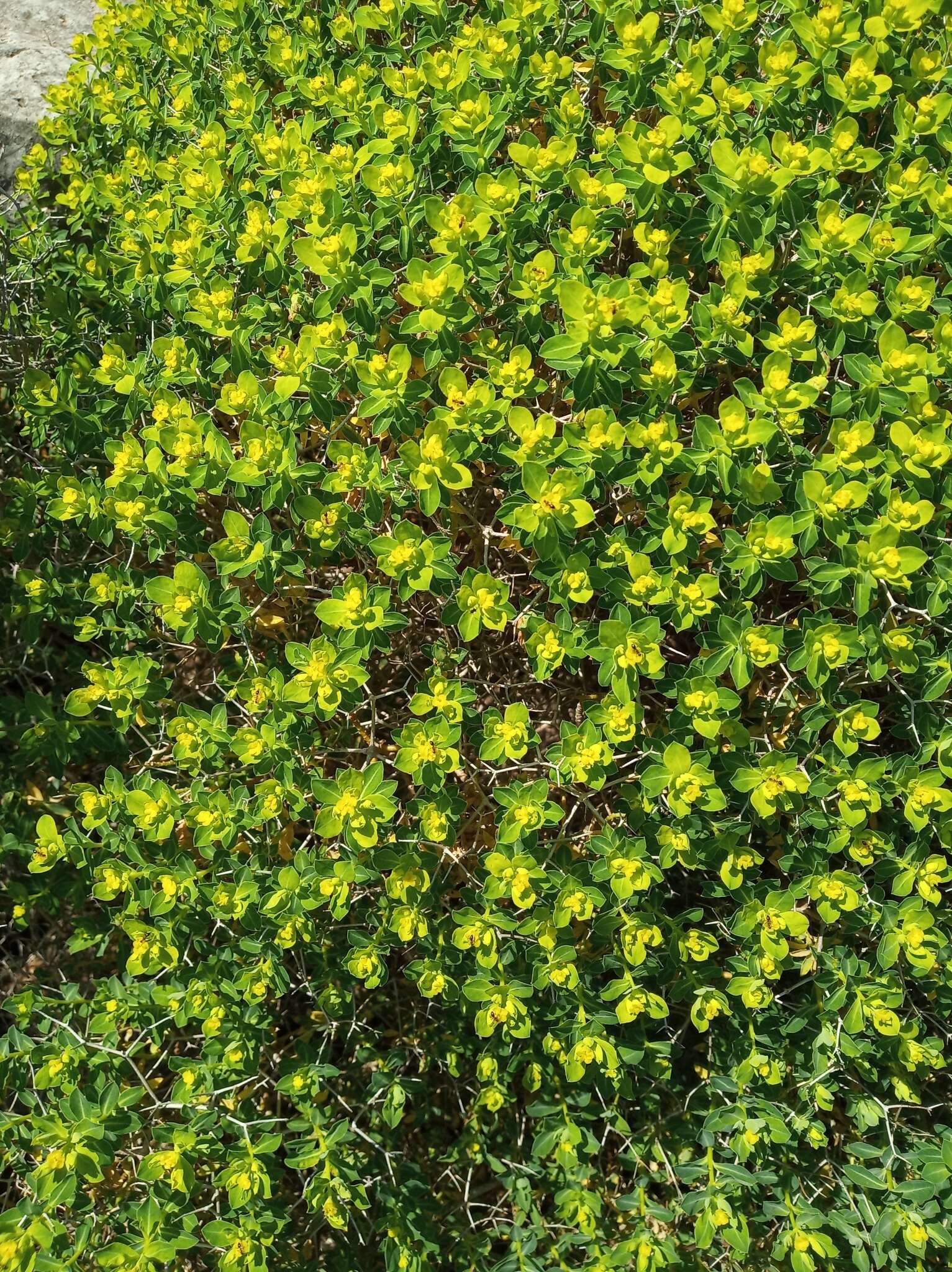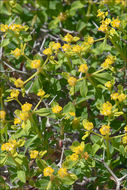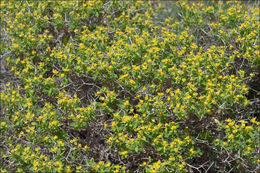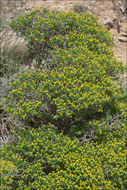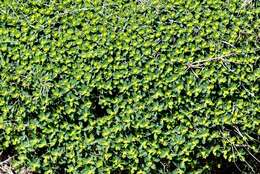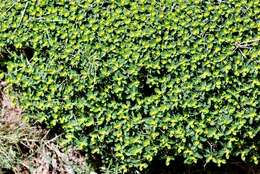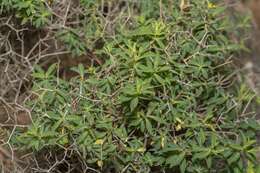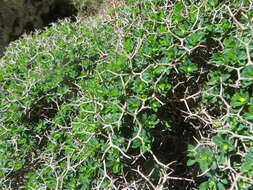-

Habitat: light, mountain, cypresses (Cupressus sempervirens) wood, moderately steep mountain slope; south aspect, rocky, skeletal ground; in shade; elevation 1.030 m (4.100 feet); average precipitations ~ 1.250 mm/year, average temperature 6-8 deg C (estimated ?), Mediterranean phytogeographical region. Substratum: soil.Comment: Euphorbia acanthothamnos is another member of the large group of grazing-resistant plants of Crete - thorny to perfection! It sometimes forms stands covering large areas of phrygana (a type of Mediterranean garrigue, an open community of dwarf evergreen shrubs). Numerous characteristically rounded, golden hummocks in bloom offer wonderful vistas. It can be found from sea level to montane elevations (up to 2.000 m on Crete). Euphorbia is a huge and very interesting genus. About 1.600 species are known spread all over the globe. Many of them are impressive from habitus aspect as well as capable to display wonderful and large scale color impressions. Plants are of very diverse habitus - from small herbs to trees and lianas. All of them have unusually shaped flowers not at all resembling 'traditionally' shaped having pistils, anthers, corolla and calyx. Male and female flowers are separate but in discrete groups (cyathia) set in a cup shaped involucre (whorls of special leaves - bracts- subtending flower cluster).Euphorbia acanthothamnos is a common plant but endemic to east Mediterranean and limited to Greece, Aegean islands, Crete and west Anatolian in Turkey. It forms low, rounded, intricately branched, regularly forked and dense shrubs. Its flowers stand in umbels with usually three to four branches. Next year these branches become woody and spine-tipped and die. However, they remain permanent weaponry against hungry sheep and goats.Ref.:(1) I. Schnfelder, P. Schnfelder, Kosmos Atlas Mittelmeer- und Kanarenflora, Kosmos, (2002), p 106.(2) M. Blamey, C. Grey-Wilson, Wild Flowers of the Mediterranean, A & C Black, London (2005), p 118.(3) V. Papiomytoglou, Wildblumen aus Friechenland, Mediterrane Editions (2006), p 88.(4) I. Schnfelder, P. Schnfelder, Was blht am Mittelmeer? Kosmos (2000), p 68.
-

Habitat: light, mountain, cypresses (Cupressus sempervirens) wood, moderately steep mountain slope; south aspect, rocky, skeletal ground; in shade; elevation 1.030 m (4.100 feet); average precipitations ~ 1.250 mm/year, average temperature 6-8 deg C (estimated ?), Mediterranean phytogeographical region. Substratum: soil.Comment: Euphorbia acanthothamnos is another member of the large group of grazing-resistant plants of Crete - thorny to perfection! It sometimes forms stands covering large areas of phrygana (a type of Mediterranean garrigue, an open community of dwarf evergreen shrubs). Numerous characteristically rounded, golden hummocks in bloom offer wonderful vistas. It can be found from sea level to montane elevations (up to 2.000 m on Crete). Euphorbia is a huge and very interesting genus. About 1.600 species are known spread all over the globe. Many of them are impressive from habitus aspect as well as capable to display wonderful and large scale color impressions. Plants are of very diverse habitus - from small herbs to trees and lianas. All of them have unusually shaped flowers not at all resembling 'traditionally' shaped having pistils, anthers, corolla and calyx. Male and female flowers are separate but in discrete groups (cyathia) set in a cup shaped involucre (whorls of special leaves - bracts- subtending flower cluster).Euphorbia acanthothamnos is a common plant but endemic to east Mediterranean and limited to Greece, Aegean islands, Crete and west Anatolian in Turkey. It forms low, rounded, intricately branched, regularly forked and dense shrubs. Its flowers stand in umbels with usually three to four branches. Next year these branches become woody and spine-tipped and die. However, they remain permanent weaponry against hungry sheep and goats.Ref.:(1) I. Schnfelder, P. Schnfelder, Kosmos Atlas Mittelmeer- und Kanarenflora, Kosmos, (2002), p 106.(2) M. Blamey, C. Grey-Wilson, Wild Flowers of the Mediterranean, A & C Black, London (2005), p 118.(3) V. Papiomytoglou, Wildblumen aus Friechenland, Mediterrane Editions (2006), p 88.(4) I. Schnfelder, P. Schnfelder, Was blht am Mittelmeer? Kosmos (2000), p 68.
-

Habitat: light, mountain, cypresses (Cupressus sempervirens) wood, moderately steep mountain slope; south aspect, rocky, skeletal ground; in shade; elevation 1.030 m (4.100 feet); average precipitations ~ 1.250 mm/year, average temperature 6-8 deg C (estimated ?), Mediterranean phytogeographical region. Substratum: soil. Comment: Euphorbia acanthothamnos is another member of the large group of grazing-resistant plants of Crete - thorny to perfection! It sometimes forms stands covering large areas of phrygana (a type of Mediterranean garrigue, an open community of dwarf evergreen shrubs). Numerous characteristically rounded, golden hummocks in bloom offer wonderful vistas. It can be found from sea level to montane elevations (up to 2.000 m on Crete). Euphorbia is a huge and very interesting genus. About 1.600 species are known spread all over the globe. Many of them are impressive from habitus aspect as well as capable to display wonderful and large scale color impressions. Plants are of very diverse habitus - from small herbs to trees and lianas. All of them have unusually shaped flowers not at all resembling 'traditionally' shaped having pistils, anthers, corolla and calyx. Male and female flowers are separate but in discrete groups (cyathia) set in a cup shaped involucre (whorls of special leaves - bracts- subtending flower cluster). Euphorbia acanthothamnos is a common plant but endemic to east Mediterranean and limited to Greece, Aegean islands, Crete and west Anatolian in Turkey. It forms low, rounded, intricately branched, regularly forked and dense shrubs. Its flowers stand in umbels with usually three to four branches. Next year these branches become woody and spine-tipped and die. However, they remain permanent weaponry against hungry sheep and goats. Ref.: (1) I. Schnfelder, P. Schnfelder, Kosmos Atlas Mittelmeer- und Kanarenflora, Kosmos, (2002), p 106. (2) M. Blamey, C. Grey-Wilson, Wild Flowers of the Mediterranean, A & C Black, London (2005), p 118. (3) V. Papiomytoglou, Wildblumen aus Friechenland, Mediterrane Editions (2006), p 88. (4) I. Schnfelder, P. Schnfelder, Was blht am Mittelmeer? Kosmos (2000), p 68.
-
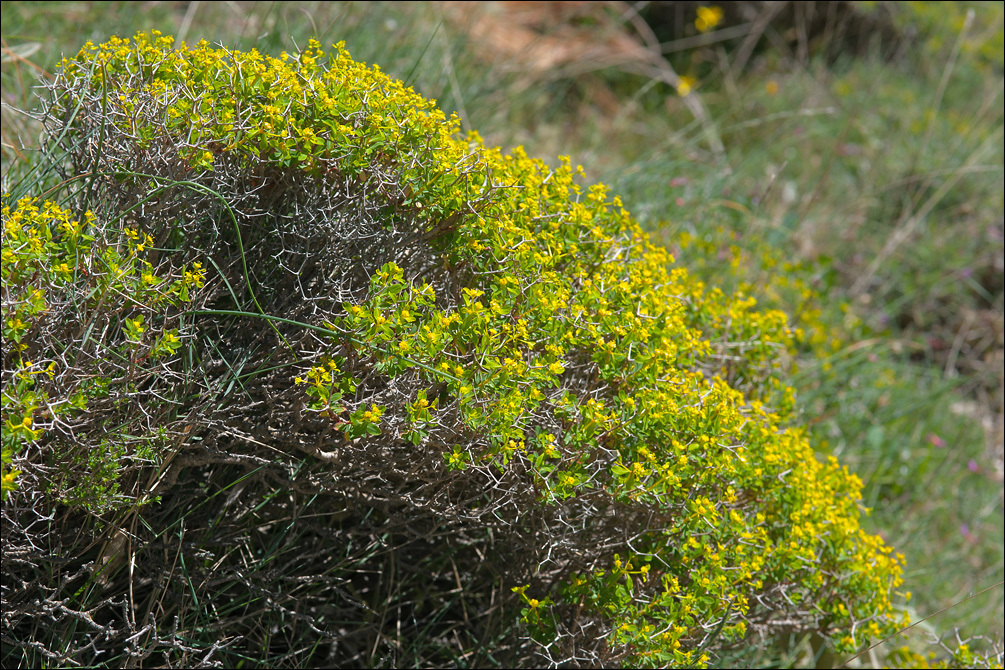
Habitat: light, mountain, cypresses (Cupressus sempervirens) wood, moderately steep mountain slope; south aspect, rocky, skeletal ground; in shade; elevation 1.030 m (4.100 feet); average precipitations ~ 1.250 mm/year, average temperature 6-8 deg C (estimated ?), Mediterranean phytogeographical region. Substratum: soil. Comment: Euphorbia acanthothamnos is another member of the large group of grazing-resistant plants of Crete - thorny to perfection! It sometimes forms stands covering large areas of phrygana (a type of Mediterranean garrigue, an open community of dwarf evergreen shrubs). Numerous characteristically rounded, golden hummocks in bloom offer wonderful vistas. It can be found from sea level to montane elevations (up to 2.000 m on Crete). Euphorbia is a huge and very interesting genus. About 1.600 species are known spread all over the globe. Many of them are impressive from habitus aspect as well as capable to display wonderful and large scale color impressions. Plants are of very diverse habitus - from small herbs to trees and lianas. All of them have unusually shaped flowers not at all resembling 'traditionally' shaped having pistils, anthers, corolla and calyx. Male and female flowers are separate but in discrete groups (cyathia) set in a cup shaped involucre (whorls of special leaves - bracts- subtending flower cluster). Euphorbia acanthothamnos is a common plant but endemic to east Mediterranean and limited to Greece, Aegean islands, Crete and west Anatolian in Turkey. It forms low, rounded, intricately branched, regularly forked and dense shrubs. Its flowers stand in umbels with usually three to four branches. Next year these branches become woody and spine-tipped and die. However, they remain permanent weaponry against hungry sheep and goats. Ref.: (1) I. Schnfelder, P. Schnfelder, Kosmos Atlas Mittelmeer- und Kanarenflora, Kosmos, (2002), p 106. (2) M. Blamey, C. Grey-Wilson, Wild Flowers of the Mediterranean, A & C Black, London (2005), p 118. (3) V. Papiomytoglou, Wildblumen aus Friechenland, Mediterrane Editions (2006), p 88. (4) I. Schnfelder, P. Schnfelder, Was blht am Mittelmeer? Kosmos (2000), p 68.
-

Habitat: light, mountain, cypresses (Cupressus sempervirens) wood, moderately steep mountain slope; south aspect, rocky, skeletal ground; in shade; elevation 1.030 m (4.100 feet); average precipitations ~ 1.250 mm/year, average temperature 6-8 deg C (estimated ?), Mediterranean phytogeographical region. Substratum: soil. Comment: Euphorbia acanthothamnos is another member of the large group of grazing-resistant plants of Crete - thorny to perfection! It sometimes forms stands covering large areas of phrygana (a type of Mediterranean garrigue, an open community of dwarf evergreen shrubs). Numerous characteristically rounded, golden hummocks in bloom offer wonderful vistas. It can be found from sea level to montane elevations (up to 2.000 m on Crete). Euphorbia is a huge and very interesting genus. About 1.600 species are known spread all over the globe. Many of them are impressive from habitus aspect as well as capable to display wonderful and large scale color impressions. Plants are of very diverse habitus - from small herbs to trees and lianas. All of them have unusually shaped flowers not at all resembling 'traditionally' shaped having pistils, anthers, corolla and calyx. Male and female flowers are separate but in discrete groups (cyathia) set in a cup shaped involucre (whorls of special leaves - bracts- subtending flower cluster). Euphorbia acanthothamnos is a common plant but endemic to east Mediterranean and limited to Greece, Aegean islands, Crete and west Anatolian in Turkey. It forms low, rounded, intricately branched, regularly forked and dense shrubs. Its flowers stand in umbels with usually three to four branches. Next year these branches become woody and spine-tipped and die. However, they remain permanent weaponry against hungry sheep and goats. Ref.: (1) I. Schnfelder, P. Schnfelder, Kosmos Atlas Mittelmeer- und Kanarenflora, Kosmos, (2002), p 106. (2) M. Blamey, C. Grey-Wilson, Wild Flowers of the Mediterranean, A & C Black, London (2005), p 118. (3) V. Papiomytoglou, Wildblumen aus Friechenland, Mediterrane Editions (2006), p 88. (4) I. Schnfelder, P. Schnfelder, Was blht am Mittelmeer? Kosmos (2000), p 68.
-

Habitat: light, mountain, cypresses (Cupressus sempervirens) wood, moderately steep mountain slope; south aspect, rocky, skeletal ground; in shade; elevation 1.030 m (4.100 feet); average precipitations ~ 1.250 mm/year, average temperature 6-8 deg C (estimated ?), Mediterranean phytogeographical region. Substratum: soil. Comment: Euphorbia acanthothamnos is another member of the large group of grazing-resistant plants of Crete - thorny to perfection! It sometimes forms stands covering large areas of phrygana (a type of Mediterranean garrigue, an open community of dwarf evergreen shrubs). Numerous characteristically rounded, golden hummocks in bloom offer wonderful vistas. It can be found from sea level to montane elevations (up to 2.000 m on Crete). Euphorbia is a huge and very interesting genus. About 1.600 species are known spread all over the globe. Many of them are impressive from habitus aspect as well as capable to display wonderful and large scale color impressions. Plants are of very diverse habitus - from small herbs to trees and lianas. All of them have unusually shaped flowers not at all resembling 'traditionally' shaped having pistils, anthers, corolla and calyx. Male and female flowers are separate but in discrete groups (cyathia) set in a cup shaped involucre (whorls of special leaves - bracts- subtending flower cluster). Euphorbia acanthothamnos is a common plant but endemic to east Mediterranean and limited to Greece, Aegean islands, Crete and west Anatolian in Turkey. It forms low, rounded, intricately branched, regularly forked and dense shrubs. Its flowers stand in umbels with usually three to four branches. Next year these branches become woody and spine-tipped and die. However, they remain permanent weaponry against hungry sheep and goats. Ref.: (1) I. Schnfelder, P. Schnfelder, Kosmos Atlas Mittelmeer- und Kanarenflora, Kosmos, (2002), p 106. (2) M. Blamey, C. Grey-Wilson, Wild Flowers of the Mediterranean, A & C Black, London (2005), p 118. (3) V. Papiomytoglou, Wildblumen aus Friechenland, Mediterrane Editions (2006), p 88. (4) I. Schnfelder, P. Schnfelder, Was blht am Mittelmeer? Kosmos (2000), p 68.
-
N of Samaria Canyon, Crete, Greece
-
N of Samaria Canyon, Crete, Greece
-
-
-
-
-
-
-
-
-
-
-
-
-
-
-
-

